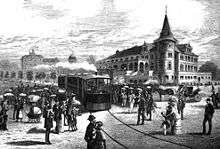Stiglmaierplatz
Stiglmaierplatz is a square in the Munich district of Maxvorstadt. It was named in 1845 after the artist Johann Baptist Stiglmaier and was previously the Kronprinzenplatz[1] and since 1826 it was known as the Ludwigplatz.[2]

Traffic

Today, Stiglmaierplatz is crossed in a northwestern direction by Dachauer Straße; shortly before which the multi-lane traffic of Seidlstraße flows into it at the level of the tram train station to the south and ends here. From the east, Brienner Straße ends at Stiglmaierplatz and merges into Nymphenburger Straße to the west. Schleißheimer Straße begins in the northeast. The square can be reached by public transport via subway lines 1 and 7 and tram lines 20, 21 and 22.
History

In the Middle Ages the square lay on a road leading from the Neuhauser Tor to Schleißheim and at the latest from the end of the 14th century served as a starting point for horse races on the so-called Rennweg, which ran where today's Schleißheimer Straße was built.[3] From 1448 the races were held annually during the Jakobidult on the route from the Neuhauser Tor in the direction of Feldmoching, which was also known as the Rennweg until 1878.[4] Not far north of today's Stiglmaierplatz, the country estate Wiesenfeld was located from the end of the 18th century.[5]
References
- Klaus Anton Altenbuchner. "Königsplatz, München" (in German). Historisches Lexikon Bayerns. Retrieved 14 November 2019.
- Dollinger, Hans (2007). Die Münchner Straßennamen (in German). Munich: Südwest-Verlag.
- Solleder, Fridolin (1938). München im Mittelalter (in German). Munich - Berlin: Verlag R. Oldenbourg. p. 148.
- Regnet, Carl Albert (1923). München in Guter Alter Zeit (in German). Munich: Hugendubel Heinrich GmbH. p. 119. ISBN 3880342520.
- Baeumler, Klaus. "Frühe Spuren Jüdischen Lebens in der Maxvorstadt" (in German). Maxvorstadt.net. Archived from the original on 4 March 2016. Retrieved 14 November 2019.
External links
| Wikimedia Commons has media related to Stiglmaierplatz. |